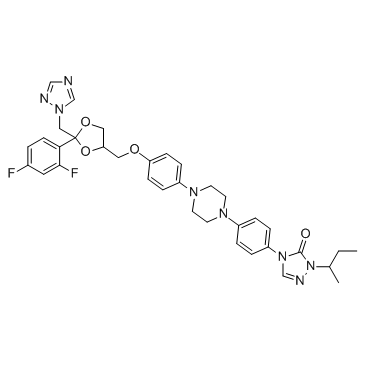110588-57-3
| Name | saperconazole |
|---|---|
| Synonyms |
2-(1H-1,2,4-Triazol-1-ylmethyl)-2-(2,4-difluorophenyl)-4-[[4-[4-[4-[[2-(1-methylpropyl)-2,3-dihydro-3-oxo-4H-1,2,4-triazol]-4-yl]phenyl]piperazin-1-yl]phenoxy]methyl]-1,3-dioxolane
2-sec-Butyl-4-[4-[4-[4-[[2-(1H-1,2,4-triazole-1-ylmethyl)-2-(2,4-difluorophenyl)-1,3-dioxolane-4-yl]methoxy]phenyl]-1-piperazinyl]phenyl]-2,4-dihydro-3H-1,2,4-triazole-3-one R66905 |
| Description | R66905 is a broad-spectrum antifungal triazole and has potent activity against Aspergillus with an MIC90 of 0.19 mg/L. |
|---|---|
| Related Catalog | |
| Target |
MIC90: 0.19 mg/L[1] |
| In Vitro | The antifungal activity of R66905 (saperconazole) is complete at 1 μg/mL for all but one strain of A. niger. Eighty percent of all strains show complete absence of growth at 0.1 μg/mL (85% for A. fumigatus), and this result persists during 14 days of the test[2]. |
| In Vivo | All control pigeons infect with A. fumigatus die within 2 to 5 days. They have necrotic foci in the lungs, air sacs, liver, spleen, and kidneys. These organs are highly positive by histology and oncultures. R66905 (saperconazole) administered at 2.5 mg/kg is not active, but when it is given at 5 or 10 mg/kg, 92 or 100%, respectively, survive and organ cultures are negative. No drug-related side effects are observed in the pigeons[2]. |
| Cell Assay | A total of 279 Aspergillus isolates are tested in vitro; 221 of these are A. fumigatus. The inoculum consists of a standardized 4 mm2 culture block containing hyphae and spores for tubes with 5 mL of medium supplemented with drug solution or with solvent[2]. |
| Animal Admin | Male immunocompetent (normal) or immunocompromised pigs weighing 500 g (±50 g) are infected intravenously (i.v.) with 25,000 CFU of A.fumigatus B19119 per g of body weight. The animals are treated orally with R66905 (saperconazole), ketoconazole, or fluconazole dissolved in polyethylene glycol 200 (PEG 200). The treatment is given once daily for 14 consecutive days, starting on the day of infection or on day 1, 2, 3, or 4 after infection. R66905, dissolved in dimethyl-β-cyclodextrin and in hydroxypropyl-β-cyclodextrin is also administered i.p. and i.v. Pigeons with a mean weight of 400 g (±30 g) are infected i.v. in a wing vein with 7,800 CFU of A.fumigatus B19119 per g of body weight. R66905 dissolved in PEG 200 is administered by gavage at 0, 2.5, 5, or 10 mg/kg starting on the day of infection and continued once daily for 14 consecutive days[2]. |
| References |
| Density | 1.37g/cm3 |
|---|---|
| Boiling Point | 812.5ºC at 760mmHg |
| Melting Point | 189.5° |
| Molecular Formula | C35H38F2N8O4 |
| Molecular Weight | 672.72400 |
| Flash Point | 445.2ºC |
| Exact Mass | 672.29800 |
| PSA | 104.70000 |
| LogP | 4.67870 |
| Vapour Pressure | 1.81E-26mmHg at 25°C |
| Index of Refraction | 1.656 |
